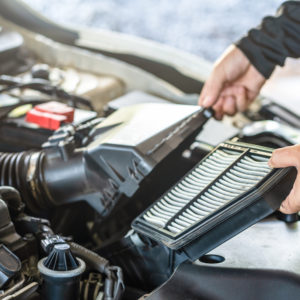Intercoolers are typically found in turbocharged or supercharged engines. These engines compress the air flowing into the cylinder to boost performance, however, compressed air gets hot very quickly, and hot air has less oxygen per cubic inch than cold air.
While not all supercharged or turbocharged engines use intercoolers, most of them do. Intercoolers counteract temperature spikes and regulate heat, minimizing the risk of an overheating engine.
Intercoolers use either air or intercooler fluid to divert heat from the engine, releasing it into the atmosphere. This keeps the engine’s temperature stable and optimal, maximizing power and performance.

Intercooler Types
There are two different types of intercoolers to keep in mind: air-to-air intercoolers, and air-to-water intercoolers. Both perform the same purpose in the sense that they regulate the temperature of an engine, but both accomplish this in different ways.
Air-to-Air Intercoolers
Air-to-air intercoolers are heat exchangers, much like a radiator, except that the heated compressed air from the supercharger or turbocharger passes through the intercooler and gives up its heat to the air passing through the external fins on the intercooler. Thus, the intercooler cools the compressed air from the turbocharger or supercharger by dissipating it into the atmosphere and providing the engine with cool, oxygen-rich air.
There are two types of air-to-air intercoolers: tube-and-fin intercoolers and bar-and-plate intercoolers.
Tube-and-fin intercoolers cool down the air with tubes that transfer heat away from the engine, substituting it with colder air. On the other hand, bar-and-plate intercoolers let the heated air pass through a heat sink made up of bars and plates.
Air-to-Water Intercoolers
Instead of using air to vent and dissipate heat, air-to-water intercoolers use intercooler fluid in the same way that radiators use coolant.
Air-to-water intercoolers pump liquid that absorbs heat from compressed air before sending it back to the intake manifold. The liquid is then cooled down by a radiator and the process repeats.
They’re generally seen as more effective than air-to-air intercoolers because they’re smaller, and are capable of working with a wider range of temperatures. Air-to-water intercoolers are more effective at cooling down the engine because of the fluid’s heat-absorbent qualities, but they are also more expensive.

What are the Benefits of Having an Intercooler?
Here are some of the biggest benefits that come with using an intercooler.
Improved Performance
Intercoolers increase the amount of air an engine takes in, allowing denser, more oxygen-rich air to enter the engine. This improves both fuel efficiency and power and reduces emission levels. Intercoolers also reduce engine knocking.
Easy to Set Up
Intercoolers are small and easy to install, but the plumbing required can be difficult. They are also installed on most vehicles with turbocharged and supercharged engines by default.
For vehicles that don’t have them, it’s recommended to leave the intercooler installation to professionals and mechanics. You can also install intercoolers yourself with the proper tools and know-how – especially if you’re already familiar with your vehicle’s engine.
Intercooler vs. Radiator: What’s the Difference?
Intercoolers and radiators are heat exchangers, which means they’re both used to reduce the temperature of whatever is flowing through them, but for different reasons. The difference between the two of them, however, lies in the fact that radiators absorb heat from the coolant whereas intercoolers absorb heat from compressed air coming from the supercharger or the turbocharger.
Frequently Asked Questions
Here are some of the most commonly asked questions regarding intercoolers.
Where is the intercooler located in a car?
Intercoolers are typically located in the engine beside the turbocharger or the supercharger.
What does an intercooler do on a turbo?
Intercoolers absorb the heat from the compressed air after it leaves the supercharger or turbocharger for better engine performance. They have very little to do with engine temperature.
Do intercoolers make cars go faster?
Because intercoolers can improve a vehicle’s performance and power, drivers can push the limits of their engines further and go faster than usual.
Get the Right Intercooler You Need Online
Some vehicles need intercoolers because they have turbochargers or superchargers that create a lot of heat. Since intercoolers are essentially small radiators for these components, any problems with the intercooler is going to cause major issues with the turbocharger. This can cause your vehicle to show an array of concerning symptoms such as excessive smoke, unusual noises, and significant power loss. Think you have a faulty intercooler? Replace it with one from CarParts.com.
Whether you own a truck, an SUV, or a sports car, you can find an intercooler that will fit your needs here at CarParts.com. We offer a wide range of intercoolers made for specific vehicles. For your peace of mind, we source all our parts from the leading aftermarket brands. Simply enter your vehicle’s specifications into the required fields and you’ll see products compatible with your ride.
A compromised intercooler is going to show a lot of glaring symptoms. Replace it as soon as possible and shop for a new intercooler today!
Any information provided on this Website is for informational purposes only and is not intended to replace consultation with a professional mechanic. The accuracy and timeliness of the information may change from the time of publication.































